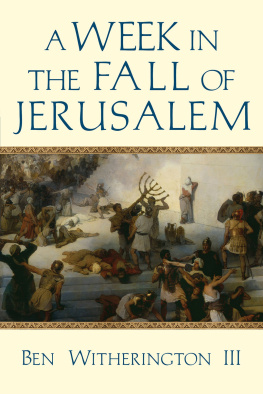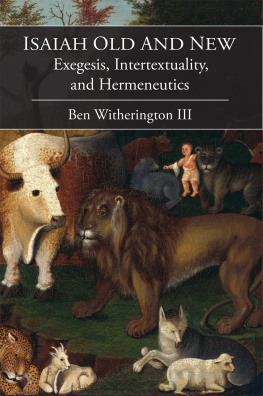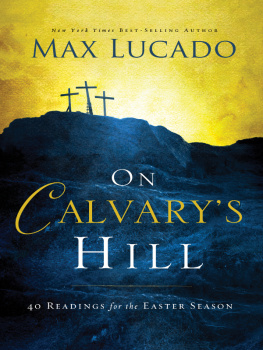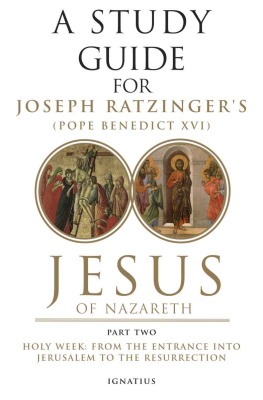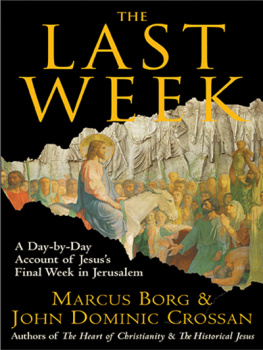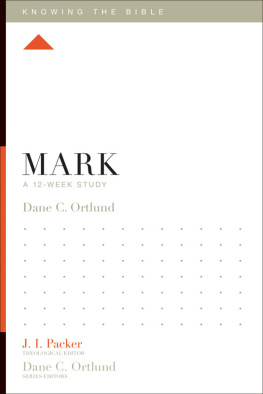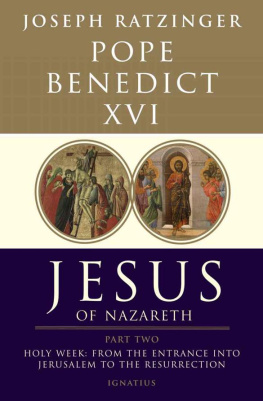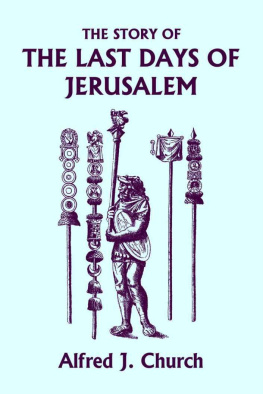Sommaire
Pagination de l'dition papier
Guide
A WEEK IN
THE FALL OF
JERUSALEM
BEN WITHERINGTON III
InterVarsity Press
P.O. Box 1400, Downers Grove, IL 60515-1426
ivpress.com
2017 by Ben Witherington III
All rights reserved. No part of this book may be reproduced in any form without written permission from InterVarsity Press.
InterVarsity Pressis the book-publishing division of InterVarsity Christian Fellowship/USA, a movement of students and faculty active on campus at hundreds of universities, colleges, and schools of nursing in the United States of America, and a member movement of the International Fellowship of Evangelical Students. For information about local and regional activities, visit intervarsity.org.
All Scripture quotations, unless otherwise indicated, are taken from the Holy Bible, Todays New International VersionCopyright 2001 by International Bible Society. All rights reserved.
Cover design: Cindy Kiple
Interior design: Beth McGill
Images: Destruction of Jerusalem, Cameraphoto Arte, Venice / Art Resource, NY
ISBN 978-0-8308-9284-6 (digital)
ISBN 978-0-8308-5173-7 (print)
This digital document has been produced by Nord Compo.
Where Theres Smoke
JOANNA AWOKE SUDDENLY to the sound of a shofar blowing, its long, piercing call cleaving the cool morning air. It was barely cockcrow. The sun had not yet penetrated the cracks of the windowless house. Rousing herself, she sat up on her improvised couch. The acrid smell of smoke snapped her out of drowsiness. It was not the smell of wood or sacrificeperhaps tar or pitch?
Shofar
A shofar is a trumpet-like instrument made by hollowing out a horn, usually a rams horn. The horns vary in shape and size depending on the age and size of the animal from which they were taken. Typically used at Jewish festivals such as Yom Kippur (the Day of Atonement) or Passover, it can also be used in synagogue services. This horn is first mentioned in the Bible in connection with Gods appearance at Mount Sinai (Ex 19:16). A shofar could also be used to signal the beginning of a battle (Josh 6:4; Judg 3:27; 7:16; 1 Sam 8:3). The sound of the shofar was distinguishable from the trumpet, and this is significant in our story, as the Romans used trumpets, not shofars, to give military signals.
Fear rose in her chest in a familiar way, and brought back a time in her life when it had been her constant companion. Joanna had returned to Jerusalem from Roma after her husband, Andronicus, had been martyred during Neros crackdown four years earlier. Andronicus had been swept up by the same Roman net that had caught the Jesus followers Peter and then Paul. None of them emerged alive from their time in the wretched prison called Tullianum. Andronicus had been crucified near the Appian Way. Joanna still shuddered whenever that memory came to mind. So the recent crisis in Jerusalem triggered memories of past traumas, mingled with tears.
Joanna had come to Jerusalem a couple of months ago to care for her ailing sister, Sarah. It had been a bold venture on her part, since the city was surrounded by Tituss army. But her plan of circling around the city and entering from the southwest, near the city of David, had succeeded. Under the cover of darkness, Joanna had managed to sneak into the city at a point where the Roman troops were less concentrated. Her sister, who suffered in her breathing, had eventually been confined to her bed despite weeks of Joannas best efforts. Only three days ago, on the day before the Sabbath, she had been gathered to her ancestors and interred in a makeshift grave in the southern part of the city, in the Hinnom Valley. In the midst of her grief, Joanna had wrestled with what she should do next. Now, awakened by the shofar, a new urgency possessed her.
Tullianum
The Tullianum, known in the Middle Ages as the Mamertine Prison, was a cave carved out of solid rock on the northeast slope of the Capitoline Hill in Rome. It was reserved for criminals accused of heinous crimes before their trial or execution. While prisoners were traditionally held at the Campus Martius, the military headquarters on the edge of Rome, it seems that if a special prisoner was going to be publicly executed after a trial before the emperor, they might be held in a special holding cell like the Tullianum. For the Romans, imprisonment was not a punishment. It was a holding pattern until the prisoner was exonerated, penalized, or executed.
Panic gripped her throat, but she mastered it and began to take mental stock. There had been a short-lived hope when Vespasian had withdrawn from Jerusalem and returned to Rome that the Romans might just leave. But recently Titus, Vespasians son, had brought more troops, and now the siege of the city was well and truly under way. Food was scarce, and many had been feeling desperate, trapped within the holy city. The Zealots and their henchmen had taken control of most everything going on within, except for a few of the temple functions.
But why was the shofar blowing at this hour, and so insistently? Surely it was some kind of warning. Dread filled Joannas mind. It was all of a piece with the dread she had experienced almost a generation ago, when her Master had been executed by Roman crucifixion outside this very city.
Suddenly there were cries in the street, a scrambling of sandaled feet, the grinding roll of cart wheels on cobbled pavement along with shouts of Fire! Fire! Joanna instinctively grabbed some essentialsunleavened bread, dates, figs, olives, a small flask of wineand thrust them in her traveling satchel. Slipping on her best cloak, she stepped out into the darkness and was nearly overrun by a little ox cart rumbling toward the Sheep Gate.
Whats happening? she shouted to a young man running alongside the cart.
The Romans have breached the wall on the far side of the temple! Theyve set fires and poured pitch over the wall from their siege towerright on the Zealots. You must flee!
But where could she run? As she drew near the Sheep Gate, she could see the flickering lantern lights of Roman soldiers coming up the hill to the gate itself. Quickly she doubled back. Now she could see flames illuminating the far side of the city. She tightened in fear, breath shortened, hands clenched, flushed with perspiration. The shofar continued its piercing wail. She could hear the sounds of fighting, the screams of wounded men. This was no place for an old woman like herself. For a moment she thought of going to the house of John Marks mother. But no, they had packed up and left the city days ago. Her mouth was dry and she wished for a drink as she stumbled on.
The Jewish Revolt
The Jewish Wars, as they were called by the Jewish historian Josephus, began long before the temple fell in AD 70. The wars involved a general revolt in Judea and Galilee, led by Zealots, a Jewish sect, and their henchmen (called sicarii, or dagger men). Emperor Vespasian had no idea at the outset that it would take his army years to put down the revolt in this tiny corner of his empireJudea, Galilee, and Samaria and their environs were no more than about 120 miles north to south, and sixty miles at the widest point east to west.

